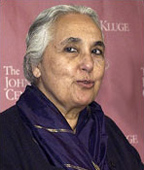by ROMILA THAPAR
 Historian Romila Thapar PHOTO/Wikipedia
Historian Romila Thapar PHOTO/Wikipedia
Which Text Is History
When we turn to these texts for their ideas on history, and this has been done and is continuing to be done, various problems have surfaced. Among them, are the problems of the range of versions of the texts, and of their periods of composition. There are many versions either of an entire text or of segments of the texts. Even if we take what are regarded by some as the earliest versions of the epics, each was put together over a period of a few centuries. The period of composition is debated, some taking it from about 400 BC to AD 400, others arguing for one century but the particular century remains uncertain.
Composition over a period of time means diverse authors, so we need to ask who they were and what were their frameworks of reference? The Valmiki Ramayana, in the period between 400 BC and AD 400, had at least two contenders – the Buddhist version, the Dasaratha Jataka, and the Jaina version, Vimalasuri’s Paumachariyam – both contradicting the Valmiki version. In the Buddhist version Rama and Sita are siblings, and in the Jaina version Ravana is not a rakshasa but a respectable member of the Meghavahana lineage and the fantasies of the other Ramayana are given rational explanations.
Narrative segments from the Mahabharata, some linked to the main events, when narrated in the Jatakas are not always in agreement with the epic. Yet the way in which the narrative is told and events explained gives us a glimpse of a sense of history in historical texts. The Buddhist and Jaina versions are alternate texts to the Valmiki and Vyasa versions. Should we just ignore these or do we ask why are they saying something different? What does this mean for historical reconstruction?
Each century produced different versions of the epic stories, some with significant variations. They were composed in a variety of languages by a variety of authors all over the subcontinent. And then the Mahabharata and the Ramayana narratives spread to south-east Asia and, apart from being sculpted as panels on temple walls, were also rendered into epic texts in various local languages by local authors. Are these still to be treated as the authentic histories of India, conveying the Indian sense of history?
Economic & Political Weekly for more
